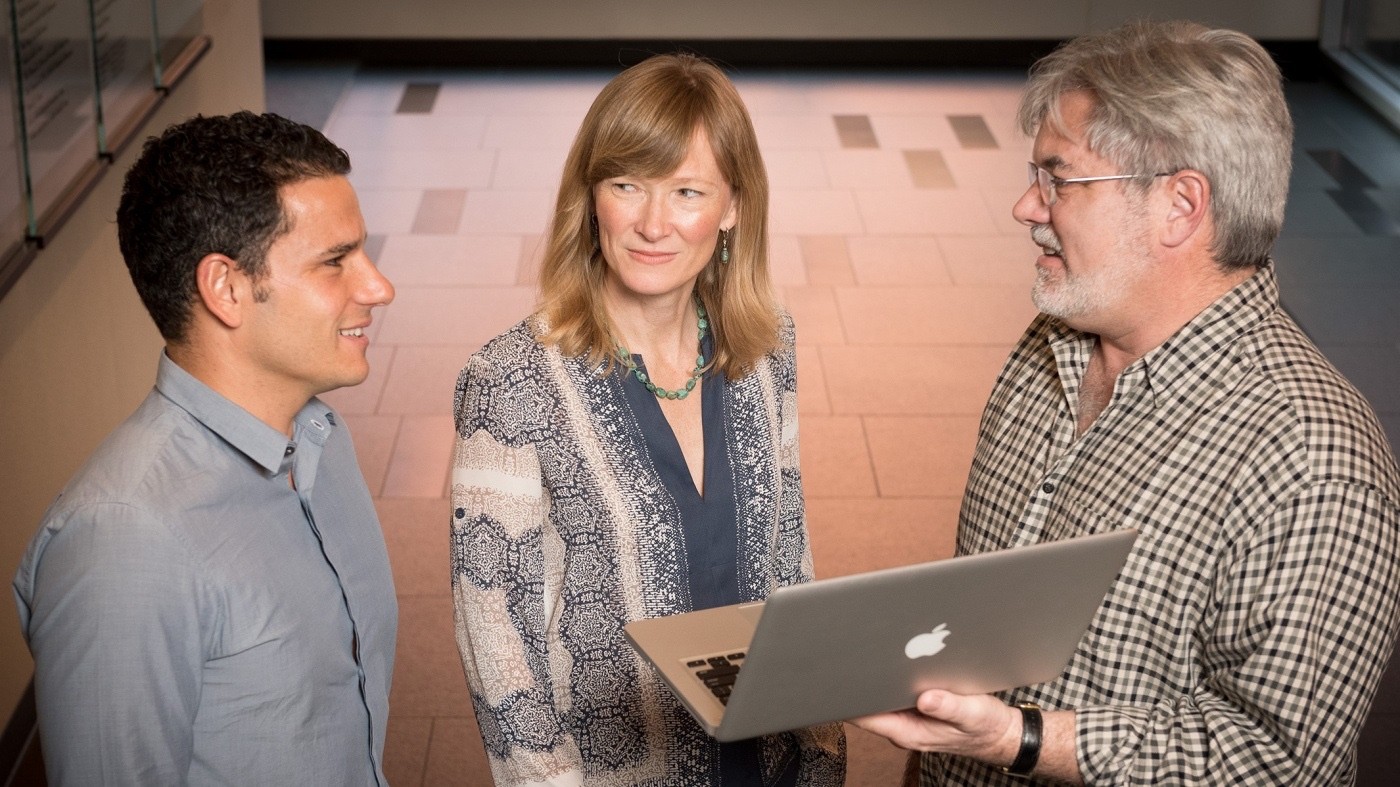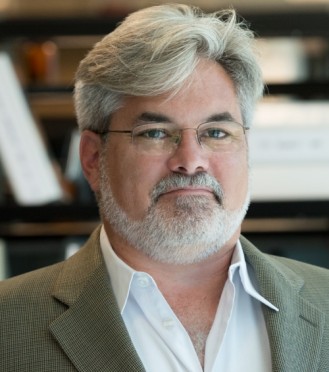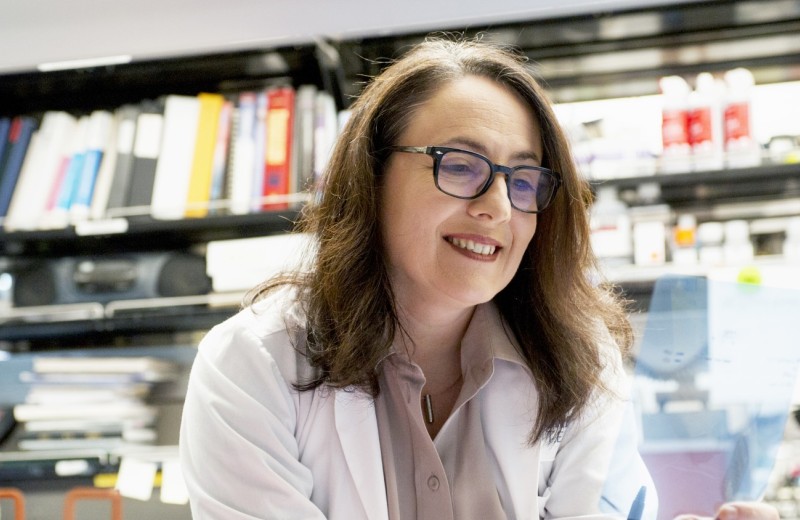Gladstone NOW: The Campaign Join Us on the Journey✕

A cross-disciplinary collaboration between preclinical scientists at the Gladstone Institutes and clinical researchers from the UCSF Memory and Aging Center seeks to connect the clinic and the laboratory and improve the translation of Alzheimer’s disease research. Left to right: Pascal Sanchez, PhD, Kate Possin, PhD, Steve Finkbeiner, MD, PhD. [Photo: Chris Goodfellow, Gladstone Institutes]
Clinical scientists at the University of California, San Francisco (UCSF) Memory and Aging Center have teamed up with preclinical researchers at the Gladstone Institutes to advance Alzheimer’s disease research by developing a comparable test of learning and memory for humans as the one most commonly used in mice. This cross-disciplinary collaboration is a first in neurological disease research.
Mouse models are useful for studying Alzheimer’s disease, but they have their limitations when comparing results in humans. To date, all promising drugs that cured or prevented dementia in mice have failed in the clinic. One potential reason for this discrepancy is that the laboratory tests used in animal models of the disease do not resemble the clinical assessments given to patients, and thus are not predictive of human memory performance.
In the new study, published in the Journal of Clinical Investigation, preclinical and clinical scientists came together to address this problem. They developed a virtual version of the Morris water maze—a widely used method of assessing learning and memory in mice—so that results could be compared more easily and accurately across species.
“So far, there has been a poor track record of moving things from preclinical discoveries into successful clinical trials,” says senior author Steve Finkbeiner, MD, PhD, a senior investigator at the Gladstone Institute of Neurological Disease and a professor of neurology and physiology at UCSF. “The motivation for this research was to assess how similar the two species are in terms of problem-solving and learning in order to improve the translation of research between mice and humans. The insights we gain can help us better understand how outcomes from drug trials in a mouse might translate to a human.”
The study compared the performance of normal and Alzheimer’s disease (AD) model mice on the Morris water maze with the performance of healthy control subjects and early-stage AD patients on a video game version of the task. In the maze, mice must swim to a platform that is hidden in the water. The animals execute the task several times, which requires remembering where the platform is located based on visual cues around the pool. In the video game version, participants hunt for buried treasure in a circular field, also using visual cues from the environment to remember where the treasure is hidden.
Both assessments test spatial learning and require proper activation of the hippocampus, a brain structure that is one of the regions affected earliest in Alzheimer’s disease. Both the patients and AD model mice were significantly impaired in terms of the distance traveled and the time it took for them to locate the hidden object.
Previous adaptations of the Morris water maze for humans varied significantly from the original in their design and performance measures. In contrast, the current virtual version included the same design and metrics as the water maze. The study also used different statistical methods than previous investigations, critically analyzing the animal and human data together, which improved test sensitivity across the two species.
“The beauty of this translational work is that we merged the studies and performed all of the analysis using the same methodology, so for the first time we were able to compare deficits directly across species,” says co-first author Pascal Sanchez, PhD, a staff research scientist at Gladstone. “It was fascinating to observe that both mouse models of Alzheimer’s disease and patients in the early stage of this condition had very similar levels of deficits on the task. We can now test therapeutic strategies using the same memory test across species.”
The new test is being used in research programs at the UCSF Memory and Aging Center, which employs advanced diagnostic techniques, including genetics, imaging, behavioral assessments, neurology, and neuropsychology to treat people with age-related brain diseases. “It is exciting to integrate the basic science research of the Gladstone Institutes with the clinical science of the Memory and Aging Center,” says co-first author Kate Possin, PhD, an assistant professor of neuropsychology at the UCSF Memory and Aging Center. “We think that this type of close collaboration will lay the groundwork for finding a cure for Alzheimer’s disease.”
Support Our COVID-19 Research Efforts
Gladstone scientists are moving quickly to respond to the coronavirus outbreak. Help us end this pandemic.
Science in Seconds | The Thinking Microscope: Research Powered by an AI Brain
Science in Seconds | The Thinking Microscope: Research Powered by an AI Brain
In this video, Steve Finkbeiner and Jeremy Linsley showcase Gladstone’s groundbreaking “thinking microscope”—an AI-powered system that can design, conduct, and analyze experiments autonomously to uncover new insights into diseases like Alzheimer’s, Parkinson’s, and ALS.
Gladstone Experts ALS Alzheimer’s Disease Parkinson’s Disease Neurological Disease Finkbeiner Lab AI Big DataKaterina Akassoglou Receives Zenith Fellows Award to Advance Alzheimer’s Research
Katerina Akassoglou Receives Zenith Fellows Award to Advance Alzheimer’s Research
Akassoglou has opened doors to understanding how the blood protein fibrin is involved in Alzheimer’s and other neurodegenerative diseases.
Awards News Release Alzheimer’s Disease Center for Neurovascular Brain Immunology Akassoglou LabMeet Gladstone: Oscar Yip
Meet Gladstone: Oscar Yip
Oscar Yip is advancing Alzheimer’s research in Yadong Huang’s lab at Gladstone while drawing inspiration from his family, community, and his broader goal of helping patients.
Graduate Students and Postdocs Profile Alzheimer’s Disease




